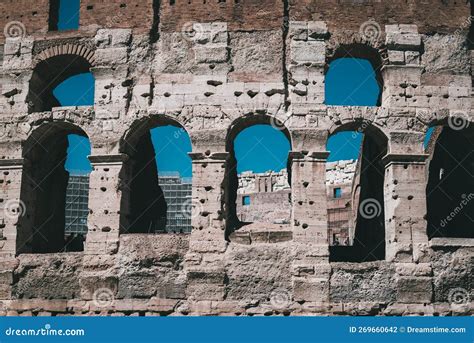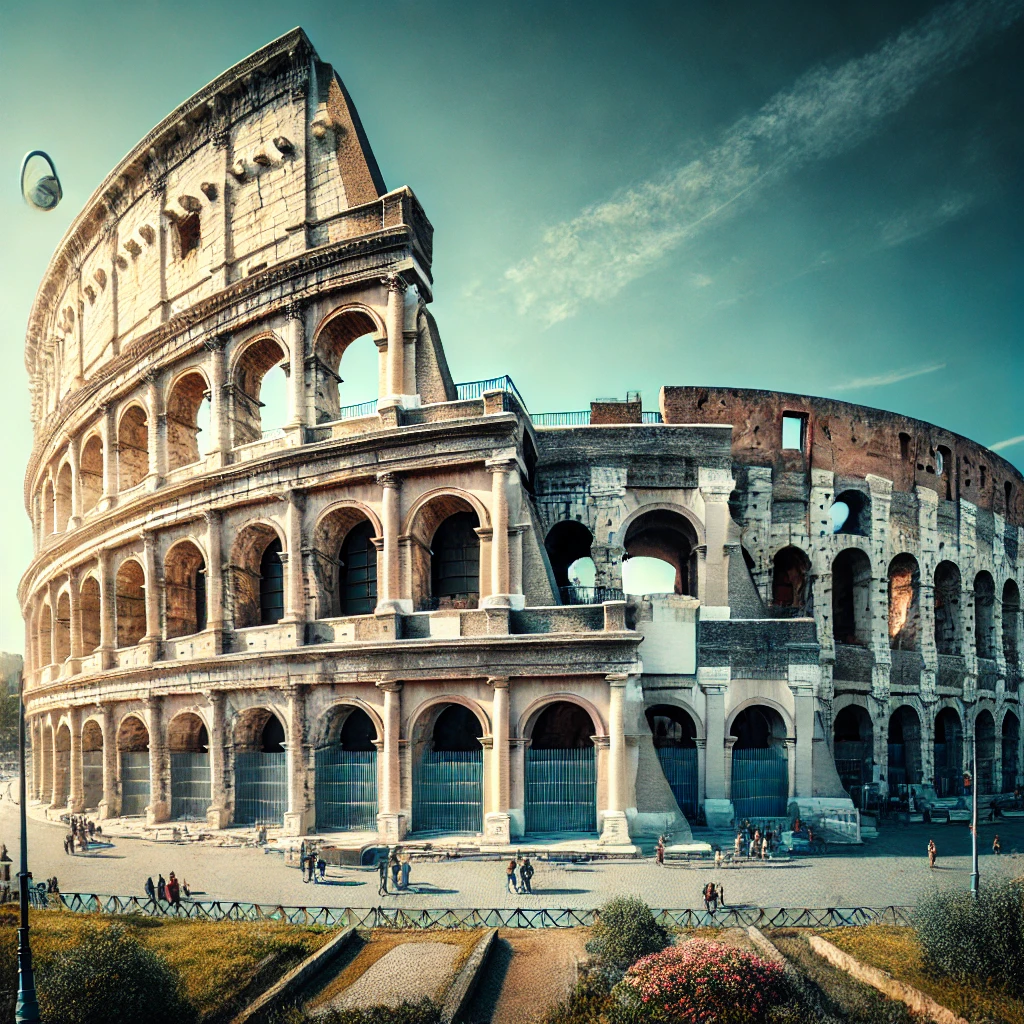The Roman Colosseum, an iconic symbol of ancient Rome, served multiple purposes beyond its famous gladiatorial contests. This architectural marvel was a center of entertainment, political propaganda, and social gatherings for the Roman Empire. Built in the 1st century AD, the Colosseum hosted a variety of spectacles, including animal hunts, executions, and re-enactments of famous battles. Its design and capacity allowed for massive crowds, showcasing the empire’s power and engineering prowess. The Colosseum also played a crucial role in Roman society, reflecting the complex relationship between the rulers and the public. Today, it stands as a testament to Roman ingenuity and a window into the ancient world’s social dynamics.
The Colosseum’s multifaceted role in Roman life extended far beyond mere entertainment. It was a powerful tool for emperors to maintain social order and demonstrate their authority. The grand spectacles held within its walls served as a form of public distraction, keeping the masses occupied and content. Additionally, the Colosseum was a place where social hierarchies were both displayed and reinforced, with seating arrangements reflecting one’s status in society. The structure itself was a marvel of Roman engineering, featuring innovative designs like the hypogeum – an underground network of tunnels and cages for animals and gladiators. The Colosseum’s influence on architecture and entertainment venues continues to this day, making it not just a relic of the past, but a lasting influence on modern society.
The Colosseum as a Symbol of Roman Power and Engineering

The Roman Colosseum, also known as the Flavian Amphitheatre, stands as an iconic symbol of the Roman Empire’s unparalleled power and engineering prowess. Constructed between 70-80 AD under the reign of Emperor Vespasian, this colossal structure was designed to showcase Rome’s grandeur and technological superiority to the world. The sheer scale and complexity of the Colosseum’s architecture served as a testament to the empire’s wealth, resources, and advanced engineering capabilities.
The Roman Colosseum‘s innovative design incorporated numerous architectural marvels that were far ahead of their time. Its elliptical shape, measuring 189 meters long, 156 meters wide, and 50 meters high, could accommodate an astounding 50,000 to 80,000 spectators. The elaborate system of underground chambers, known as the hypogeum, housed complex machinery and elevators used to transport gladiators, animals, and stage props to the arena floor, creating spectacular and dramatic entrances for the entertainment of the crowds.
One of the most impressive features of the Roman Colosseum was its advanced crowd management system, which included:
- Numbered entrances and exits for efficient crowd flow
- A sophisticated seating arrangement based on social hierarchy
- A retractable awning system (velarium) to protect spectators from sun and rain
These engineering marvels not only demonstrated Rome’s technological superiority but also served as a powerful propaganda tool, reinforcing the empire’s dominance and ability to provide for its citizens.
Gladiatorial Contests and Public Spectacles: Entertainment in Ancient Rome

The Roman Colosseum served as the epicenter of entertainment in ancient Rome, hosting a variety of public spectacles that captivated the masses and showcased the empire’s power and grandeur. Gladiatorial contests, perhaps the most famous of these events, were brutal displays of combat that pitted skilled warriors against one another in a fight to the death, satisfying the Roman appetite for violence and spectacle. These highly anticipated matches drew enormous crowds, with spectators from all social classes gathering to witness the thrilling and often gruesome battles that unfolded within the arena’s walls.
In addition to gladiatorial contests, the Roman Colosseum hosted an array of other public spectacles designed to entertain and awe the populace. Animal hunts, or venationes, were particularly popular, featuring exotic beasts from far-flung corners of the empire pitted against skilled hunters or condemned criminals. These events not only provided entertainment but also served as a demonstration of Rome’s vast reach and dominion over nature. Naval battles, or naumachiae, were occasionally staged within the flooded arena, offering a unique and impressive display of naval warfare that showcased the empire’s maritime prowess.
The spectacles held at the Roman Colosseum were more than mere entertainment; they played a crucial role in Roman society, serving as a means of social control and political manipulation. Emperors used these events to curry favor with the masses, providing
Political and Social Significance of the Colosseum in Roman Society

The Roman Colosseum, an iconic symbol of ancient Rome’s grandeur, played a pivotal role in shaping the political and social landscape of the empire. This magnificent amphitheater, commissioned by Emperor Vespasian in 70 AD and completed by his son Titus in 80 AD, served as more than just a venue for entertainment; it was a powerful tool for political manipulation and social control. The Colosseum’s ability to host massive crowds of up to 50,000 spectators made it an ideal platform for emperors to showcase their power, generosity, and connection to the people.
One of the primary political functions of the Roman Colosseum was to provide a stage for emperors to demonstrate their munificence through the concept of ‘bread and circuses’ (panem et circenses). This strategy involved providing free entertainment and food to the masses as a means of maintaining social order and political stability. By hosting elaborate spectacles, including gladiatorial contests, animal hunts, and mock naval battles, emperors could distract the populace from political issues and economic hardships while simultaneously reinforcing their own authority and popularity.
The social significance of the Roman Colosseum extended far beyond mere entertainment. It served as a microcosm of Roman society, reflecting and reinforcing the hierarchical structure of the empire. The seating arrangements within the amphitheater were strictly organized according to social status:
| Seating Level | Social Class |
|---|---|
| Podium (Ground Level) | Emperor, Senators, Vestal Virgins |
| Maenianum Primum | Equestrians (Knights) |
| Maenianum Secundum | Ordinary Roman Citizens |
| Summum Maenianum | Poorest Citizens, Slaves, Women |
This visual representation of social hierarchy served to reinforce the existing social order and remind citizens of their place within the empire. Moreover, the Colosseum acted as a unifying force, bringing together people from all walks of life to share in a common experience, albeit from different vantage points. The shared excitement and emotions generated during the spectacles fostered a sense of collective identity among the Roman populace, transcending social boundaries and strengthening the fabric of Roman society.
Frequently Asked Questions

The main purpose of the Roman Colosseum was to serve as a large arena for public spectacles, including gladiatorial contests, animal hunts, and mock sea battles.The Colosseum reflected Roman society by showcasing the values of bravery, entertainment, and social hierarchy, facilitating a space where citizens could gather for entertainment and distract from political issues.The Colosseum is unique for its use of the arch, its massive scale, and its advanced engineering techniques, including a complex system of vaults and the ability to host thousands of spectators.Various events were held in the Colosseum, including gladiatorial fights, animal hunts, naval battles, mock executions, and public spectacles.The emperor played a central role during events at the Colosseum, often serving as a host to the games, deciding the fate of gladiators, and providing lavish entertainment to gain public favor.The Colosseum could accommodate around 50,000 to 80,000 spectators, making it one of the largest amphitheaters of its time.After the fall of the Roman Empire, the Colosseum fell into disrepair, was repurposed for various uses, and suffered damage from earthquakes and stone robbers.


